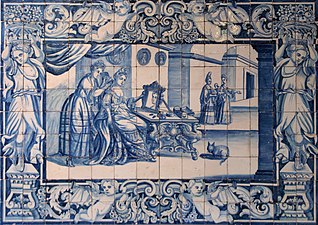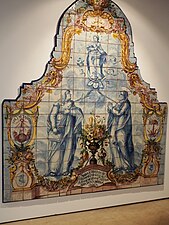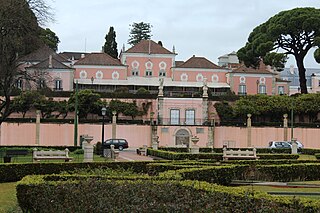
The Belém Palace, formally the National Palace of Belém,, is the current official residence of the President of the Portuguese Republic, the head of state of Portugal. Located in the Belém District of Lisbon, the palace's main façade fronts the Praça Afonso de Albuquerque, facing the Tagus River. A former residence of the Portuguese Royal Family, the Belém Palace complex is made up of various buildings, wings, courtyards, and gardens, built variously from the 18th to 21st centuries.

Azulejo is a form of Spanish and Portuguese painted tin-glazed ceramic tilework. Azulejos are found on the interior and exterior of churches, palaces, ordinary houses, schools, and nowadays, restaurants, bars and even railways or subway stations. They are an ornamental art form, but also had a specific functional capacity like temperature control in homes.

The Museu Nacional de Arte Antiga, also known in English as the National Museum of Ancient Art, is a Portuguese national art museum located in Lisbon. With over 40,000 items spanning a vast collection of painting, sculpture, goldware, furniture, textiles, ceramics, and prints, MNAA is one of the most visited museums in Portugal.

Jorge Afonso was a noted Portuguese Renaissance painter.

Cristóvão Lopes was a Portuguese painter.

The National Coach Museum is located on the Afonso de Albuquerque Square in the Belém district of Lisbon in Portugal. The museum has one of the finest collections of historical carriages in the world and is one of the most visited museums of the city.
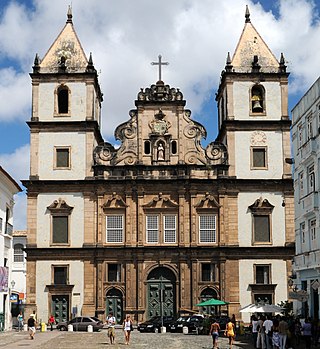
The São Francisco Church and Convent of Salvador is located in the historical centre of Salvador, in the State of Bahia, Brazil. The ornate Church of the Third Order of Saint Francis sits adjacent to the convent. The friars of the Franciscan Order arrived in Salvador in 1587 and constructed a convent and church on the site. This structure was destroyed by the Dutch during the Dutch invasions of Bahia in the next century; Father Vicente das Chagas initiated the current structure in 1686, which was completed in the 18th century. The Franciscan church and convent have the largest number of azulejos, 55,000, of any church in Latin America.
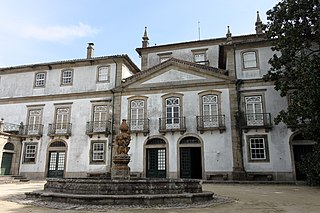
The Residence of Biscainhos, is a former-signeurial residence located in civil parish of Braga, in the municipality of Braga, in northern Portuguese district of Braga.
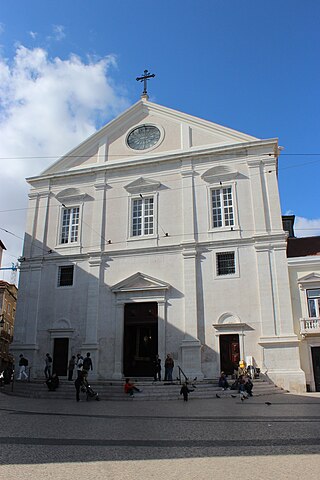
The Igreja de São Roque is a Roman Catholic church in Lisbon, Portugal. It was the earliest Jesuit church in the Portuguese world, and one of the first Jesuit churches anywhere. The edifice served as the Society's home church in Portugal for over 200 years, before the Jesuits were expelled from that country. After the 1755 Lisbon earthquake, the church and its ancillary residence were given to the Lisbon Holy House of Mercy to replace their church and headquarters which had been destroyed. It remains a part of the Holy House of Mercy today, one of its many heritage buildings.

Gilded woodcarving in Portugal is, along with tile, one of the country's most original and rich artistic expressions. It is usually used in the interior decoration of churches and cathedrals and of noble halls in palaces and large public buildings. An impressive collection of altarpieces are found in Portuguese churches. Originating in the Gothic era, Portuguese gilded woodcarving assumed a nationalist character during the 17th century and reached its height in the reign of King D. João V. In the 19th century it lost its originality and began to disappear with the end of the revival era.
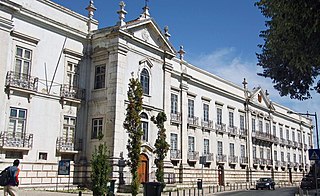
Penha de França is a freguesia and typical quarter of Lisbon, the capital of Portugal. Located in the historic center of Lisbon, Penha de França is north of São Vicente, east of Arroios, south of Areeiro, and west of Beato. The population in 2011 was 27,967,
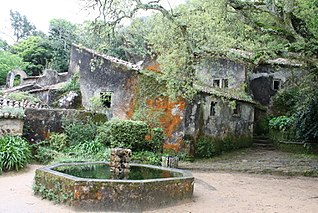
The Convent of the Friars Minor Capuchin, popularly known as the Convent of the Capuchos, but officially the Convento de Santa Cruz da Serra da Sintra, is a historical convent consisting of small quarters and public spaces located in the civil parish of São Pedro de Penaferrim, in Sintra Municipality, Portugal. Its creation was associated with the Portuguese Viceroy of India, D. João de Castro, and his family, but became a pious community of reclusive clergy that continued to occupy cramped humble spaces in the complex until the religious orders were abolished in Portugal.
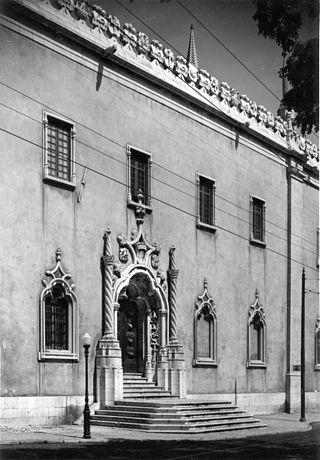
The Convento de Madre de Deus, or Madre de Deus Convent, is a former convent and church in Lisbon, Portugal, which houses the National Museum of the Azulejo. It is classified as a National Monument.
The Sintra Natural History Museum is a museum of natural history located in the historic center of the village of Sintra. The museum has both at national and international level due to the quality and rarity of many of its exhibits.
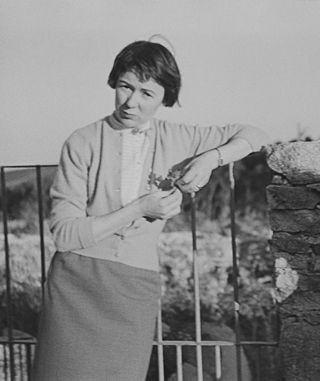
Maria Keil was a Portuguese visual artist. She was born in Silves and died in Lisbon.

The Convent of Caloura is a Portuguese 16th-century convent located in the civil parish of Água de Pau, in the municipality of Lagoa, on the island of São Miguel in the archipelago of the Azores.
Madre de Deus was a Portuguese treasure ship captured by English privateers in 1592.
The Convent of Carmo is a former-convent situated in the civil parish of Matriz, municipality of Horta in the Portuguese archipelago of the Azores. For several centuries it was one of the several convents that dotted the urban area of the island of Faial, but was damaged during several earthquakes. After the expulsion of the religious orders the convent began a slow decline, and was eventually expropriated by the Portuguese Armed Forces as an administrative post and garrison.
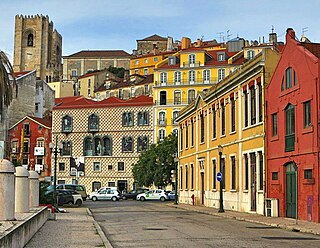
Lisbon is one of the most popular city destinations in Europe. The city of Lisbon and the Lisbon metropolitan area attracts a significant number of tourists each year, drawn to its historical and cultural heritage, good transportation connections and good touristic infrastructure.

The Ceramics Museum of Sacavém is situated in the town of Sacavém in the municipality of Loures, just northeast of Lisbon in Portugal. The museum was opened in July 2000 and was constructed on the grounds of a former ceramics factory. Most of the exhibits reflect the output of that factory and its documentation centre is devoted to the study of the history and production of the factory and the industrial heritage of the municipality. In 2002 the museum was awarded the Luigi Micheletti Prize in the Industrial Heritage category.



